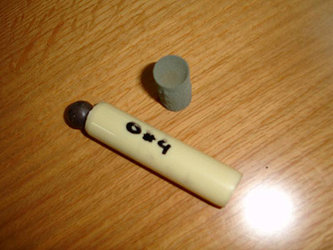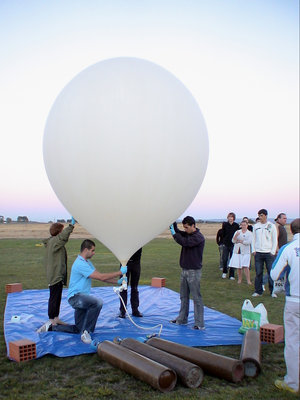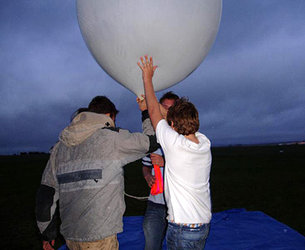Qualified success for second STRAPLEX flight
The second qualification flight of the ESA-supported Student Stratospheric Platform Experiment (STRAPLEX) began from Évora, southern Portugal, at 11 am on 23 April.
Slung beneath a 3 metre diameter helium balloon, the small STRAPLEX capsule rose steadily into cloudy skies at the start of a planned two-hour 40 minute mission. Drifting upwards at an average speed of 4.5 m/s, the balloon took approximately 127 minutes to reach an altitude of about 34 km. During the long ascent, it gradually expanded until it stretched to a diameter of 14 m.

Video images sent back to the main ground station showed that, upon completion of the ascent phase, the capsule was jettisoned as planned. After a period of rapid descent through the thin upper atmosphere, when the capsule reached a speed of 70 m/s, the parachute deployed and started to control the descent speed as expected.
Continued monitoring from the fixed ground station and a second, mobile station, indicated that the descent lasted about 35 minutes, with a controlled touchdown in the area of the Vale do Guadiana natural park.

“We are happy to say that the video link showed that the flight was normal, including the jettison of the capsule and the deployment of the parachute,” commented Guerric Pont, ESA coordinator for the STRAPLEX project.
“Unfortunately, the experiment’s primary communication system, which was to send back all of the data from the onboard instruments, failed within one minute of lift-off,” he added. “There are two possibilities. Either the antenna was bent during the launch phase or there was a failure of the diplexer.

“This meant that we did not receive the GPS coordinates that were needed to pin down its position. Instead, we had to rely on the secondary system, which was designed to transmit a beacon signal.”
Using the beacon signal, the ground team was able to triangulate its position and monitor the capsule’s progress through the ascent and most of the descent, until it dropped below the hills on the horizon. Attempts to locate the capsule after touchdown were not successful within the lifetime of the beacon batteries (36 hours).
The landing site is believed to be between the Vale do Guadiana natural park and the city of Beja, although the precise location remains uncertain. Local authorities and community representatives in the sparsely populated area have been asked to assist in finding the capsule.
“All of the data currently available indicate that the flight achieved most of its major objectives, and we are looking forward to retrieving the capsule and the data stored on board,” said Guerric Pont.

The hexagonal capsule used on the latest qualification flight was an enlarged version of the original model, with sides measuring 208 mm, a height of 310 mm and a mass of about 3.5 Kg.
The STRAPLEX-2 payload, which weighed 0.2 kg, included a biological experiment in which a number of mussels were carried aloft to experience near-space conditions. The objective was to verify the ability of this species to withstand conditions of low pressure while exposed to harsh temperatures and a lack of oxygen and water.
The capsule also carried a digital camera, absolute and differential pressure sensors, as well as sensors to measure internal and external temperature, motion and attitude. A video camera connected to a radio was used to transmit lateral images in real time to the ground stations during the flight.
A third qualification flight, to be launched from Evora, is expected to take place in the summer. It is hoped that the capsule used in the latest mission can be refurbished and modified before being used again for this flight.
Background
STRAPLEX is a programme led by the University of Porto, Portugal, in collaboration with the Education Projects Division of the European Space Agency (ESA). The programme is intended to give students practical hands-on experience and to encourage them to pursue a career in space technology and science.
STRAPLEX is intended to enable university students from ESA Member States to send experiments into the stratosphere, using helium-filled balloons. It also provides valuable opportunities to perform short-duration scientific and technological experiments in near-space conditions, and to participate in the development of future capsules.
The first STRAPLEX qualification flight, also from Évora, took place on 20 December 2005. After a successful launch and deployment of the parachute system during a flight of a little over two hours, the capsule was recovered near the Portuguese-Spanish border. The communication and navigation systems performed successfully during this mission.
Depending on the mass of the experiment, STRAPLEX can reach an altitude of up to 40 km. Two balloon campaigns, each involving six flights, are envisaged for June and September every year, starting in September 2006.
The STRAPLEX student team is currently working on three main developments of the capsule in order to enhance its capabilities:
- Increase the payload capacity up to 25 kg,
- Introduce a free-fall phase providing microgravity conditions,
- Introduce a floating phase that will provide a longer mission duration (days or weeks).











